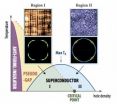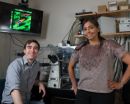(Press-News.org) CAMBRIDGE, Mass-- MIT researchers have devised a novel cancer treatment that destroys tumor cells by first disarming their defenses, then hitting them with a lethal dose of DNA damage.
In studies with mice, the research team showed that this one-two punch, which relies on a nanoparticle that carries two drugs and releases them at different times, dramatically shrinks lung and breast tumors. The MIT team, led by Michael Yaffe, the David H. Koch Professor in Science, and Paula Hammond, the David H. Koch Professor in Engineering, describe the findings in the May 8 online edition of Science Signaling.
"I think it's a harbinger of what nanomedicine can do for us in the future," says Hammond, who is a member of MIT's Koch Institute for Integrative Cancer Research. "We're moving from the simplest model of the nanoparticle — just getting the drug in there and targeting it — to having smart nanoparticles that deliver drug combinations in the way that you need to really attack the tumor."
Doctors routinely give cancer patients two or more different chemotherapy drugs in hopes that a multipronged attack will be more successful than a single drug. While many studies have identified drugs that work well together, a 2012 paper from Yaffe's lab was the first to show that the timing of drug administration can dramatically influence the outcome.
In that study, Yaffe and former MIT postdoc Michael Lee found they could weaken cancer cells by administering the drug erlotinib, which shuts down one of the pathways that promote uncontrolled tumor growth. These pretreated tumor cells were much more susceptible to treatment with a DNA-damaging drug called doxorubicin than cells given the two drugs simultaneously.
"It's like rewiring a circuit," says Yaffe, who is also a member of the Koch Institute. "When you give the first drug, the wires' connections get switched around so that the second drug works in a much more effective way."
Erlotinib, which targets a protein called the epidermal growth factor (EGF) receptor, found on tumor cell surfaces, has been approved by the Food and Drug Administration to treat pancreatic cancer and some types of lung cancer. Doxorubicin is used to treat many cancers, including leukemia, lymphoma, and bladder, breast, lung, and ovarian tumors.
Staggering these drugs proved particularly powerful against a type of breast cancer cell known as triple-negative, which doesn't have overactive estrogen, progesterone, or HER2 receptors. Triple-negative tumors, which account for about 16 percent of breast cancer cases, are much more aggressive than other types and tend to strike younger women.
That was an exciting finding, Yaffe says. "The problem was," he adds, "how do you translate that into something you can actually give a cancer patient?"
From lab result to drug delivery
To approach this problem, Yaffe teamed up with Hammond, a chemical engineer who has previously designed several types of nanoparticles that can carry two drugs at once. For this project, Hammond and her graduate student, Stephen Morton, devised dozens of candidate particles. The most effective were a type of particle called liposomes — spherical droplets surrounded by a fatty outer shell.
The MIT team designed their liposomes to carry doxorubicin inside the particle's core, with erlotinib embedded in the outer layer. The particles are coated with a polymer called PEG, which protects them from being broken down in the body or filtered out by the liver and kidneys. Another tag, folate, helps direct the particles to tumor cells, which express high quantities of folate receptors.
Once the particles reach a tumor and are taken up by cells, the particles start to break down. Erlotinib, carried in the outer shell, is released first, but doxorubicin release is delayed and takes more time to seep into cells, giving erlotinib time to weaken the cells' defenses. "There's a lag of somewhere between four and 24 hours between when erlotinib peaks in its effectiveness and the doxorubicin peaks in its effectiveness," Yaffe says.
The researchers tested the particles in mice implanted with two types of human tumors: triple-negative breast tumors and non-small-cell lung tumors. Both types shrank significantly. Furthermore, packaging the two drugs in liposome nanoparticles made them much more effective than the traditional forms of the drugs, even when those drugs were given in a time-staggered order.
As a next step before possible clinical trials in human patients, the researchers are now testing the particles in mice that are genetically programmed to develop tumors on their own, instead of having human tumor cells implanted in them.
The researchers believe that time-staggered delivery could also improve other types of chemotherapy. They have devised several combinations involving cisplatin, a commonly used DNA-damaging drug, and are working on other combinations to treat prostate, head and neck, and ovarian cancers. At the same time, Hammond's lab is working on more complex nanoparticles that would allow for more precise loading of the drugs and fine-tuning of their staggered release.
"With a nanoparticle delivery platform that allows us to control the relative rates of release and the relative amounts of loading, we can put these systems together in a smart way that allows them to be as effective as possible," Hammond says.
INFORMATION:
Morton and Lee are the lead authors of the Science Signaling paper. Postdocs Zhou Deng, Erik Dreaden, and Kevin Shopsowitz, visiting student Elise Siouve, and graduate student Nisarg Shah also contributed to the research. The work was funded by the National Institutes of Health, the Center for Cancer Nanotechnology Excellence, and a Breast Cancer Alliance Exceptional Project Grant.
Written by Anne Trafton, MIT News Office
Chemotherapy timing is key to success
Nanoparticles that stagger delivery of 2 drugs knock out aggressive tumors in mice
2014-05-08
ELSE PRESS RELEASES FROM THIS DATE:
Climate change may worsen summertime ozone pollution
2014-05-08
Ozone pollution across the continental United States will become far more difficult to keep in check as temperatures rise, according to new research results.
The study shows that Americans face the risk of a 70 percent increase in unhealthy summertime ozone levels by 2050.
The results appear online this week in a paper in the Journal of Geophysical Research-Atmospheres, published by the American Geophysical Union.
The work was funded by the National Science Foundation (NSF) and the U.S. Department of Energy.
Warmer temperatures and other changes in the atmosphere ...
Scientists find solution to 2 long-standing mysteries of cuprate superconductivity
2014-05-08
UPTON, NY—Scientists seeking to understand the intricacies of high-temperature superconductivity—the ability of certain materials to carry electrical current with no energy loss—have been particularly puzzled by a mysterious phase that emerges as charge carriers are added that appears to compete with superconductivity. It's also been a mystery why, within this "pseudogap" phase, the movement of superconducting electrons appears to be restricted to certain directions. So exploring the pseudogap and whether and how it affects the movement of electrons has been a pivotal challenge. ...
'Rice theory' explains north-south China cultural differences, study shows
2014-05-08
A new cultural psychology study has found that psychological differences between the people of northern and southern China mirror the differences between community-oriented East Asia and the more individualistic Western world – and the differences seem to have come about because southern China has grown rice for thousands of years, whereas the north has grown wheat.
"It's easy to think of China as a single culture, but we found that China has very distinct northern and southern psychological cultures and that southern China's history of rice farming can explain why people ...
Exploring the magnetism of a single atom
2014-05-08
Magnetic devices like hard drives, magnetic random access memories (MRAMs), molecular magnets, and quantum computers depend on the manipulation of magnetic properties. In an atom, magnetism arises from the spin and orbital momentum of its electrons. 'Magnetic anisotropy' describes how an atom's magnetic properties depend on the orientation of the electrons' orbits relative to the structure of a material. It also provides directionality and stability to magnetization. Publishing in Science, researchers led by EPFL combine various experimental and computational methods to ...
Plant hormone has dual role in triggering flower formation, Penn study finds
2014-05-08
Flowers aren't just pretty to look at, they are how plants reproduce. In agricultural plants, the timing and regulation of flower formation has economic significance, affecting a crop's yield.
A new paper by researchers at the University of Pennsylvania published in the journal Science has revealed that a plant hormone once believed to promote flower formation in annual plants also plays a role in inhibiting flowers from forming. The dual role of this hormone, gibberellin, could be exploited to produce higher-yielding crop plants.
The study was led by Nobutoshi Yamaguchi ...
GaitTrack app makes cellphone a medical monitor for heart and lung patients
2014-05-08
CHAMPAIGN, Ill. — By simply carrying around their cellphones, patients who suffer from chronic disease could soon have an accurate health monitor that warns their doctors when their symptoms worsen.
GaitTrack, an app developed by researchers at the University of Illinois at Urbana-Champaign and the U. of I. at Chicago, turns a smartphone into a sophisticated medical device. Unlike other apps that merely count steps, GaitTrack uses eight motion parameters to perform a detailed analysis of a person's gait, or walking pattern, which can tell physicians much about a patient's ...
Tackling test anxiety may help prevent more severe problems
2014-05-08
Showing students how to cope with test anxiety might also help them to handle their built-up angst and fretfulness about other issues. The results of a new study by Carl Weems of the University of New Orleans show that anxiety intervention programs that focus on academic matters fit well into the demands of the school routine, and do not carry the same stigma among youth as general anxiety programs do. The research group was among the first to study the effects of Hurricane Katrina on community mental health and anxiety among youths, and the paper appears in Prevention ...
Ovarian cancer cells are more aggressive on soft tissues
2014-05-08
When ovarian cancer spreads from the ovaries it almost always does so to a layer of fatty tissue that lines the gut. A new study has found that ovarian cancer cells are more aggressive on these soft tissues due to the mechanical properties of this environment. The finding is contrary to what is seen with other malignant cancer cells that seem to prefer stiffer tissues.
"What we found is that there are some cancer cells that respond to softness as opposed to stiffness," said Michelle Dawson, an assistant professor in the School of Chemical and Biomolecular Engineering ...
Army drug users twice as likely to use synthetic marijuana as regular marijuana
2014-05-08
Social work researchers from the University of Washington have found that among a group of active-duty Army personnel who use illicit drugs, the most abused substance is synthetic marijuana, which is harder to detect than other drugs through standard drug tests.
The research will be published in the July 2014 issue of Addictive Behaviors, but is already online.
Synthetic marijuana, sometimes called "Spice," is made with shredded plant material coated with chemicals that are designed to mimic THC, the psychoactive compound found naturally in marijuana. The U.S. Drug ...
Single cell genome sequencing of malaria parasites
2014-05-08
SAN ANTONIO, May 8, 2014 – A new method for isolating and genome sequencing an individual malaria parasite cell has been developed by Texas Biomed researchers and their colleagues. This advance will allow scientists to improve their ability to identify the multiple types of malaria parasites infecting patients and lead to ways to best design drugs and vaccines to tackle this major global killer. Malaria remains the world's deadliest parasitic disease, killing 655,000 people in 2010.
Malaria parasite infections are complex and often contain multiple different parasite genotypes ...
LAST 30 PRESS RELEASES:
Simple method can enable early detection and prevention of chronic kidney disease
S-species-stimulated deep reconstruction of ultra-homogeneous CuS nanosheets for efficient HMF electrooxidation
Mechanical and corrosion behavior of additively manufactured NiTi shape memory alloys
New discovery rewrites the rules of antigen presentation
Researchers achieve chain-length control of fatty acid biosynthesis in yeast
Water interactions in molecular sieve catalysis: Framework evolution and reaction modulation
Shark biology breakthrough: Study tracks tiger sharks to Maui mating hub
Mysterious iron ‘bar’ discovered in famous nebula
World-first tool reduces harmful engagement with AI-generated explicit images
Learning about public consensus on climate change does little to boost people’s support for action, study shows
Sylvester Cancer Tip Sheet for January 2026
The Global Ocean Ship-Based Hydrographic Investigations Program (GO-SHIP) receives the Ocean Observing Team Award
Elva Escobar Briones selected for The Oceanography Society Mentoring Award
Why a life-threatening sedative is being prescribed more often for seniors
Findings suggest that certain medications for Type 2 diabetes reduce risk of dementia
UC Riverside scientists win 2025 Buchalter Cosmology Prize
SETI Institute opens call for nominations for the 2026 Tarter Award
Novel theranostic model shows curative potential for gastric and pancreatic tumors
How beige fat keeps blood pressure in check
Fossils reveal ‘latitudinal traps’ that increased extinction risk for marine species
Review: The opportunities and risks of AI in mental health research and care
New map reveals features of Antarctic’s ice-covered landscape
Beige fat promotes healthy vascular function and blood pressure in mice
Chronic low-dose pesticide exposure reduces the life span of wild lake fish, China-based study shows
Tiny earthquakes reveal hidden faults under Northern California
Long-term pesticide exposure accelerates aging and shortens lifespan in fish
Professor Tae-Woo Lee's research group develops groundbreaking perovskite display technology demonstrating the highest efficiency and industry-level operational lifetime
The “broker” family helps tidy up the cell
Ecology: Mummified cheetahs discovery gives hope for species’ Arabic reintroduction
Researchers survey the ADHD coaching boom
[Press-News.org] Chemotherapy timing is key to successNanoparticles that stagger delivery of 2 drugs knock out aggressive tumors in mice



